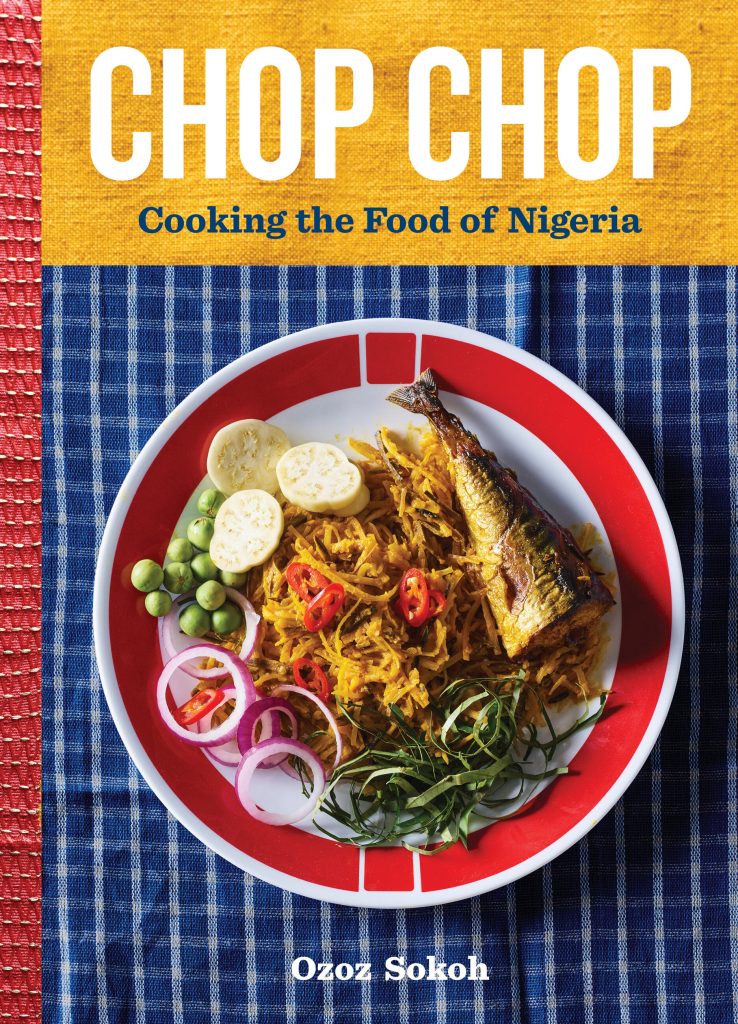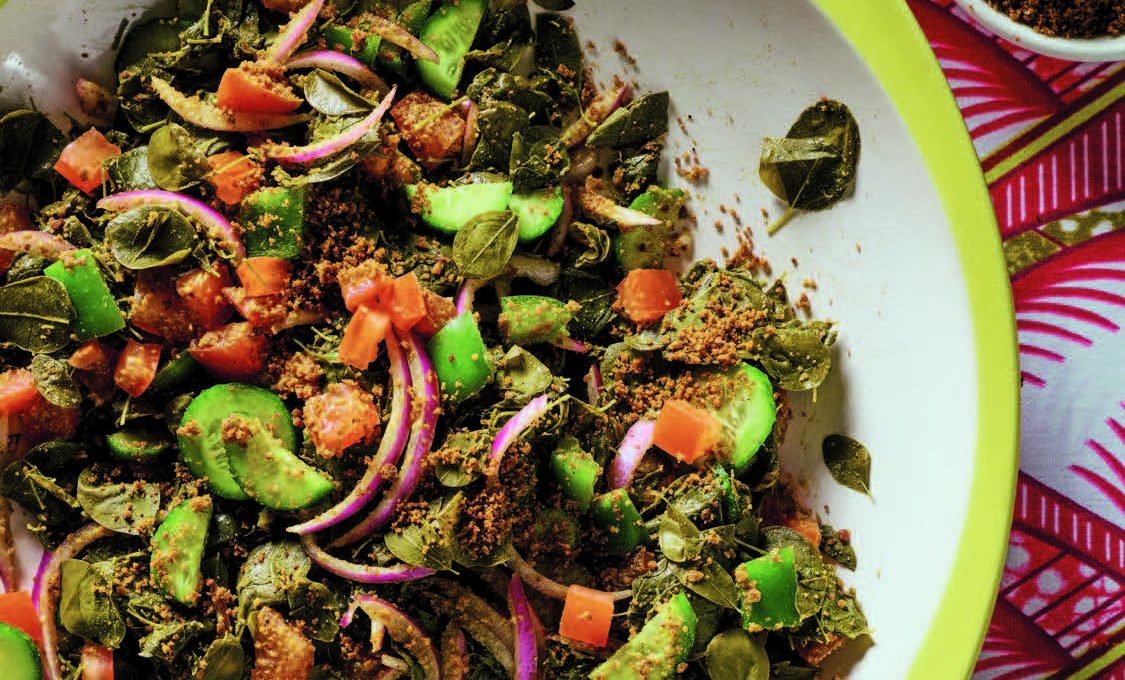Without any planning, here I am starting the 21st year of ‘Serge the Concierge’ with a recipe from Nigeria, a first in the history of this blog.
The KWADÒN ZŌGALE, Moringa Salad Recipe is one of three I chose from Chop Chop ‘Cooking the Food of Nigeria’ by Ozoz Sokoh (Artisan Books / March 18, 2025).
A geologist by training Ozoz Sokoh started sharing her food journey on her blog Kitchen Butterfly in 2009. She also offers insights on roots of West Africa and its diaspora on Feast Afrique.
KWADÒN ZŌGALE Recipe
Moringa Salad
Serves 4
Ingredients:
6 cups (250 g) fresh moringa leaves (see Notes and page 20)
1 teaspoon fine sea salt, or more as needed
1 large Roma (plum) tomato, diced
½ red onion, thinly sliced
½ medium cucumber, diced (seeded and peeled, if you like)
½ small green bell pepper, diced
¼ cup (60 ml) groundnut (peanut oil) or other neutral oil
About 1 cup (110 g) Ƙulīƙƙulī dressing (recipe follows)
4 to 8 beef seasoning cubes, for serving (see Notes; optional)
NOTES: You’ll find fresh moringa leaves in African, Indian, and even South American markets. For 6 cups (1/2 pound/250 g), you’ll need just under 1 pound (about 400 g) of greens. You can substitute lacinato kale leaves for the moringa; remove the ribs and chop the leaves before cooking, then reduce the steaming time to 10 to 12 minutes and skip the bitterness test and adjustment, too.
In the north of Nigeria, it is common not only to use stock cubes in cooking but to serve them at the table alongside meals as a condiment instead of salt.
Spicy, nutty, and earthy with some bitter notes, this salad of moringa leaves has its origins in the North West. The flavor of the leaves reminds me of the fermented tea leaves used in the classic Burmese salad laphet thoke. I steam and rinse the moringa leaves—steaming brings a silkiness to them but deepens their bitterness, hence the hot water rinse at the end. To finish? A sweet, salty, and nutty dressing.

Directions:
Pluck the moringa leaves off their stalks and discard the stalks. Rinse the leaves in a colander, then drain.
Fill a stockpot with 2 to 3 inches (5 to 7.5 cm) of water. Place a steamer basket in the pot, cover, and bring to a boil over high heat. Place the moringa leaves in the steamer basket and season with the salt. Cover the pot tightly and steam until the leaves soften, wilt, and turn dark green, 35 to 40 minutes. Taste a leaf; if you find it too bitter, remove the leaves from the steamer and dunk them in freshly boiled water for about 1 minute to rinse off some of the bitterness.
Spread the leaves on a large plate to cool for about 10 minutes, then transfer them to a large bowl. Add the tomato, onion, cucumber, and bell pepper and stir to incorporate. Drizzle the oil over the greens and vegetables. Sprinkle two-thirds of the ƙulīƙulī dressing over the greens and vegetables. Gently massage the leaves until everything is coated and evenly distributed.
Serve the salad at room temperature or chilled, with the remaining ƙulīƙulī dressing alongside salt and 1 or 2 seasoning cubes per person, if using.
Ƙulīƙulī Dressing
This dressing is made with ƙulīƙulī, groundnut (peanut) crackers that are crushed to make a crumble of sorts. It gets sprinkled and mixed into the salad base, and you can serve an extra bowlful on the side.
In a food mill or food processor, or using a mortar and pestle, break down the ƙulīƙulī until it becomes uniformly coarse and resembles almond meal. Transfer to a medium bowl or jar. Add the yaji, sugar, and salt. Crumble in 1 seasoning cube, if desired. Cover tightly or seal and shake until well blended. Taste and adjust the seasoning with more yaji, sugar, and/or salt, if needed, and crumble in some or all of the remaining seasoning cube.
Use right away, or cover and store at room temperature for up to 1 week or in the refrigerator for up to 1 month.
Makes 1 Heaping Cup (110 G)
1 cup (100 g) Ƙulīƙulī (page 277)
1 teaspoon Basic yaji (page 26), plus more as needed
1/2 teaspoon sugar, plus more as needed
1/2 teaspoon fine sea salt, plus more as needed
1 or 2 beef seasoning cubes (optional)
Kwado, Many Ways
Kwado, the collective name for salads in Hausa (a language in the north of Nigeria), features a main ingredient tossed in a sweet and nutty dressing made with neutral oil, Ƙulīƙulī (page 277), and Basic Yaji (page 26), sweetened with sugar. The name reflects the main ingredient, so a version with kabeji (cabbage) becomes kwaɗòn kabeji.
There are many directions to take this salad, from fresh vegetables—cucumbers; garden cress, also known as labsur, lausur, and (erroneously) lansir; lettuce—to steamed ones with alayyahu (amaranth greens); cooked ingredients—like rice, couscous, and pasta; or root vegetables, or a combination. Though the main ingredient can be prepared from scratch, it is also a great way to transform leftovers.
Some examples: Kwaɗòn Māsā̀ features cut-up Māsā̀ (page 85), similar to Lebanese fattoush or Italian panzanella. Boiled root vegetables like yam (page 124) and sweet potatoes work well, like potato salads. Want some protein? Add sūya (page 173) or Fried Awara (page 181). Kanzo, aka bottom pot (see page 145), the toasty, crunchy layer of rice or starch at the bottom of the pot (similar to Spanish socarrat), goes into kwaɗòn kanzo, broken up, softened in water, drained, then dressed. Regardless of the kwado you choose, the goal is a mix of textures and flavors—soft, crunchy, sweet, slightly salty, nutty, and more. Include other vegetables you enjoy, such as carrots, sweet peppers, pea eggplants, or garden eggs.
( *Excerpted from Chop Chop by Ozoz Sokoh -Artisan Books- Copyright © 2025. Photographs by James Ransom.)

Recent Comments